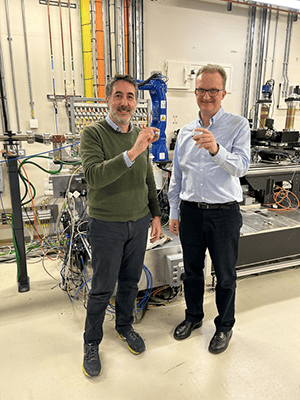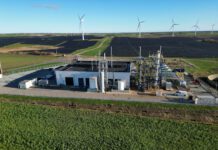
Ground-breaking work lights a path for environmental applications and accessing results from vast amounts of data
In a breakthrough that may be significant for environmental applications, researchers have imaged the porosity of biochars via “unprecedented” operando experiments, making use of facilities available at the UK’s national synchrotron, Diamond Light Source.
The work – carried out by Dr Roberto Volpe and his team at Queen Mary University of London and University College London, in cooperation with Diamond – overcomes existing knowledge gaps in the thermochemical decomposition of biomass, and could enable the production of tailor-made bio-chars for high priority environmental applications. Among other areas, biochars may have an important role to play in clean-up operations at sites where hazardous chemicals have been spilled in soil and water.
With support from a European Horizon 2020 grant called ExPaNDs- European Open Science Cloud (EOSC) Photon and Neutron Data Service – Diamond has worked with Dr Volpe on a new, data-intensive technique used at the synchrotron to accelerate access to results.
Dr Volpe’s current research involves examining and identifying the chars created from raw biomass of almond and walnut shells as their porosity is key to environmental applications. The ability to customise the morphology of these chars could herald a great breakthrough to help address global challenges by creating inexpensive and renewable solutions to energy storage, catalysis, water and soil remediation. Tracking the morphology of biomass during biochar production is the first step towards achieving this.
Observing an age-old process
“What we do is simple as we take almond and walnut shells and we put them through pyrolysis to create a char biomass – the study of carbonisation of biomass essentially reflects techniques dating back to the beginning of mankind by turning wood into charcoal. However, in our study, the process is monitored every step of the way and what we are interested in, is the porosity that is being created. By accurately heating, we can form up to more than a thousand square metres of accessible surface area in the intricate network of pores inside a single gram of formed biochars.”
He adds: “Applications for this work are many as contaminants (bacteria, metals, polluting molecules) or ions (in the case of energy storage) can be carried by water (or by an electrolyte) into the intra-particle pore network, and they can be trapped there. Tracking the evolution of this pore network as we heat the biomass particles is key and the real novelty of this work.”
In addition to traditional beamtime at Diamond, Dr Volpe has been working in collaboration on the data side of the ExPaNDs grant to develop new processes to accelerate access to data.
Dr Volpe says that the helping hand he received analysing his data from the ExPaNDs and Diamond team accelerated his research. Commenting he said that data mining of these huge datasets is a new discipline and requires extensive collaboration.
“Sharing of such large and complex sets of information is challenging and the ExPaNDS grant helped identify better ways to deliver data management which is really useful to speed up results and transparency.”
Dr Paul Quinn, Science Group Leader for Diamond explains; “Imaging techniques at Diamond allow the team to visualise the structure of the solid particle with enough detail to examine small gaps or pores and track any changes over time and with variations in temperature. This means that we can extract a great deal of detail about the evolution of these pores and their intricate geometry. This result sheds light on the fundamental behaviour of thermally treated biomass, and, at the same time, allows Dr Volpe and his team to uniquely correlate the particle and pores geometry to temperature.”
He adds: “This a great achievement made possible by the dedication of the scientists in my team. Dr Christoph Rau and the many others who have contributed to and supported the complex measurements, from advice on experiment feasibility, to experimental setup of the furnace to create the correct environment and optimal X-ray imaging conditions, to mining the wealth of data generated.”
Ensuring FAIR access to large data sets
As petabytes of data are produced in synchrotrons every year, the need for collaboration and a coordinated approach with these huge data sets is an issue facing most scientists and researchers, especially those working in large scale facilities in the UK and Europe. To increase the value of this data, it needs to follow key principles to ultimately be Findable, Accessible, Interoperable and Reusable (FAIR). These principles will help make data eventually open to all. A key goal of ExPaNDS is to make it easier to find and share research data which will help prevent repetition of experiments, spur scientific progress and make synchrotron data FAIR. A second goal of ExPaNDS is to provide guidelines on managing data to support sharing and reuse.
The ExPaNDS project is a collaboration between 10 national Photon and Neutron Research Infrastructures (PaN RIs). This community covers virtually all fields of research with a huge diversity in data management approaches. This makes harmonisation a challenge.
Professor Dr Helmut Dosch, Chairman of the Board of Directors for DESY, which is the leading partner in the ExPaNDS grant said: “We can now create solutions these days and in the future even more so – atom by atom, you know materials which can be used for fighting climate change and diseases. But this data, this information is coming with a huge avalanche of data to us, and we need concepts how to turn this data in to useful information and to knowledge. It needs the right people; it needs the right infrastructure, and it needs financial resources. But I only can say now that knowledge is expensive, but ignorance we cannot afford.”






